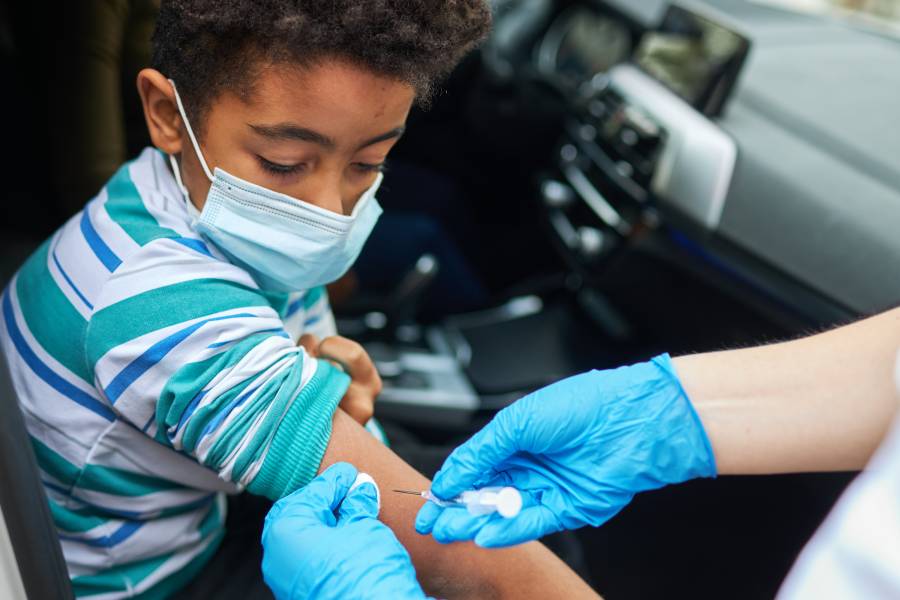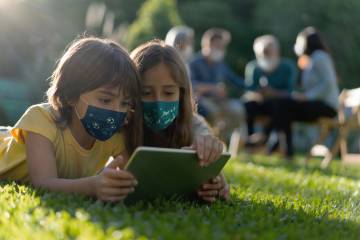For a generation of kids, the COVID-19 pandemic has emerged as the defining event of their young lives—a period marked by closures, cancellations, fear, and disruption. And while many American adults are relaxing more now as infection rates decline, the situation for children and adolescents remains uncertain. Just one vaccine is available for kids age 12 to 15, and access for younger ages is expected to take several more months. Some parents are impatient for that moment to arrive; others are concerned.
At a symposium June 30 hosted by Johns Hopkins University and the University of Washington, leaders in public health and medicine explored this complex terrain.
"I think I speak for many of us in saying that we know the pandemic has had truly devastating impacts on children and their families," said Ellen MacKenzie, dean of the Johns Hopkins Bloomberg School of Public Health. "So today, our focus concerns those impacts and the role that COVID-19 vaccines play for kids, their families, and our communities."
Rochelle Walensky, director of the U.S. Centers for Disease Control and Prevention and a Hopkins alum, said the conversation around young people and COVID-19 is often framed in the wrong way—implying that the smaller proportion of child deaths from the disease means it's less serious for children as compared to adults. "That is absolutely the wrong benchmark," she said. "Young, healthy children are not supposed to die."
Apart from deaths and hospitalizations, another rare but concerning effect of COVID-19 for young people is the development of MIS-C, an immune response marked by multi-organ inflammation that has affected more than 4,000 children in the U.S.—a disproportionate 62% of those Latinx or Black—and has caused 36 pediatric deaths, the expert panelists said. According to CDC data, about 60-70% of cases of MIS-C end up in intensive care, and 1-2% are fatal.
Moving forward, according to UW professor of medicine Larry Corey, the most important steps will be expanding vaccine access for teenagers, "following the science" in ongoing clinical trials for younger ages, and, in the meantime, providing kids with the safest and most fulfilling environments possible. Every effort, he said, should go toward ensuring that "2021 and 2022 are not lost years for this generation that 2020 was."
Among many other topics, the symposium touched upon:
Adverse effects of vaccines
Experts at the symposium acknowledged that clinical trials can't capture all of the possible side effects of vaccines, but touted the structures in place to track them in larger populations. "We have an incredibly robust post-authorization, post-licensure vaccine safety network that spans both passive reporting as well as active data capture," said Kawsar Talaat, associate professor at the Bloomberg School. For example, she noted, authorities paused Johnson & Johnson vaccinations temporarily in April after only six reported cases of blood clots.
Many are also paying close attention to reports of more than 700 cases of myocarditis or pericarditis—inflammation of the heart or heart lining—in people under 30 following full doses of the Pfizer and Moderna vaccines. According to CDC data, cases have been most prevalent in males 16 and older within days their second dose. Most patients who developed the side effect have responded well to medicine and recovered quickly.
At the symposium, experts agreed that in spite of these cases of heart inflammation, data demonstrates that the mRNA vaccines should still be considered safe for ages 12 and over—echoing the verdict a CDC committee reached last week.
"If you vaccinate a million adolescents, you can expect to avoid 8,000 cases of COVID, 200 hospitalizations, 50 ICU stays, and one death."@CDCDirector Dr. Rochelle P. Walensky explains recent data presented by the @CDCgov's Advisory Committee on Immunization Practices: pic.twitter.com/bzKZ6UkisH
— Johns Hopkins University (@JohnsHopkins) July 2, 2021
"You probably have a better chance of in playing the lottery and getting the big prize than getting this," said José Romero, chair of the CDC's Advisory Committee on Immunization Practices.
"Everyone that we've consulted unequivocally believes that the benefits of vaccination… far, far, far outweigh any risks," said David Kessler, chief scientific officer for the COVID-19 response at the U.S. Department of Health and Human Services.
Ultimately, public health experts must strike a balance, said Peter Marks, director of the Center for Biologics Evaluation and Research at the Food & Drug Administration. "We have to be transparent, but at the same time, we want to … continue to facilitate the rates of vaccination that are going to be necessary if we want to get on top of this pandemic and not have new variants break out that will ultimately come back to haunt us."
Vaccine timeline and safety
The CDC currently recommends that anyone 12 or over gets vaccinated against COVID-19, but so far only the Pfizer vaccine is available publicly for the 12-15 age group, while Moderna is seeking emergency use authorization for those ages from the FDA.
Both Pfizer and Moderna are completing late-phase clinical trials for their vaccines in the 5-11 age group, expecting to file for FDA emergency use authorization between September and December, according to Kessler from the DHHS, though he noted that six months of safety data on those trials won't be available until early 2022.
He said the U.S. has been stockpiling doses of these two mRNA vaccines to prepare for an eventual rollout for children. "So the cupboard is full," he said.
A Johnson & Johnson representative also said the company has planned four studies in pediatric populations this fall.
Vaccine development for children moves more slowly because it requires a "stepwise" approach, said Merlin Robb, chief medical officer of the Henry M. Jackson Foundation—starting with older children at low doses, then gradually incorporating younger study participants, and all completed "with an abundance of caution and in the interest of safety."
What's in store for fall
The benefits of children getting the vaccine will "depend very much on the course of the epidemic going forward, and will depend very much on the community and on the country," said Christopher Murray, director of the Institute for Health Metrics at UW. If current declining vaccination trends hold, he said, we can expect a surge in late fall driven by the highly transmissible Delta variant.
"We should expect transmission to start to go up when kids go back to school, slowly, and that does mean there are risks there," Murray said.
Several experts said they believe widespread, inexpensive, rapid tests for COVID-19 could make a big difference this fall. Rep. Kim Schrier, a former pediatrician who represents Washington state's 8th district, said a rapid-test pilot program at schools in her area brought "an increase of parent and teacher confidence in safety" while eliminating in-school transmissions. But it's time-consuming for staff, so "home is where it needs to go," Schrier said, and the current price points—around $12 per test—need to drop.
Posted in Health, Science+Technology, Politics+Society
Tagged children's health, coronavirus, covid-19, covid-19 vaccine









